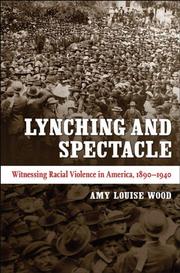| Listing 1 - 2 of 2 |
Sort by
|

ISBN: 9780807871973 0807871974 0807832545 146960356X 0807878111 9780807878118 9781469603568 9780807832547 Year: 2009 Publisher: Chapel Hill
Abstract | Keywords | Export | Availability | Bookmark
 Loading...
Loading...Choose an application
- Reference Manager
- EndNote
- RefWorks (Direct export to RefWorks)
Lynch mobs in late nineteenth- and early twentieth-century America exacted horrifying public torture and mutilation on their victims. In Lynching and Spectacle, Amy Wood explains what it meant for white Americans to perform and witness these sadistic spectacles and how lynching played a role in establishing and affirming white supremacy. Lynching, Wood argues, overlapped with a variety of cultural practices and performances, both traditional and modern, including public executions, religious rituals, photography, and cinema, all which encouraged the horrific violence and gave it social
Lynching --- Violence --- Hate crimes --- Lynchage --- Crimes haineux --- History. --- Histoire --- Etats-Unis --- United States --- Race relations --- Relations raciales --- Bias crimes --- Bias-related crimes --- Hate-motivated crimes --- Hate offenses --- Crime --- Homicide --- Anti-lynching movements --- Griffith, David Wark
Book
ISBN: 9780521883047 0521883040 9780511576379 9781107404281 9780511534348 0511534345 1107200105 1283331101 9786613331106 0511534035 0511576374 0511532636 0511531729 0511533543 1107404282 Year: 2009 Publisher: Cambridge New York Cambridge University Press
Abstract | Keywords | Export | Availability | Bookmark
 Loading...
Loading...Choose an application
- Reference Manager
- EndNote
- RefWorks (Direct export to RefWorks)
This book is a study of faction, lynching, murder, terror and counter-terror during the French Revolution. It examines factionalism in small towns like Aubagne near Marseille, and how this produced the murders and prison massacres of 1795-8. Another major theme is the convergence of lynching from below with official terror from above. Although the terror may have been designed to solve a national emergency in the spring of 1793, in southern France it permitted one faction to continue a struggle against its enemies, a struggle that had begun earlier over local issues like taxation and governance. It uses the techniques of micro-history to tell the story of the small town of Aubagne. It then extends the scope to places nearby like Marseille, Arles, and Aix-en-Provence. Along the way, it illuminates familiar topics like the activity of clubs and revolutionary tribunals and then explores largely unexamined areas like lynching, the sociology of faction, the emergence of theories of violent fraternal democracy, and the nature of the White Terror.
Justice, Administration of --- Violence --- Lynching --- Executions and executioners --- Justice --- Lynchage --- Bourreaux --- History --- Administration --- Histoire --- Aubagne (France) --- France --- Atrocities. --- Social conditions --- Atrocités --- Conditions sociales --- Atrocités --- Criminal law --- Criminal procedure --- Capital punishment --- Execution sites --- Homicide --- Violent behavior --- Social psychology --- Administration of justice --- Law --- Courts --- Law and legislation --- Aubagne, France --- Anti-lynching movements --- Arts and Humanities
| Listing 1 - 2 of 2 |
Sort by
|

 Search
Search Feedback
Feedback About UniCat
About UniCat  Help
Help News
News